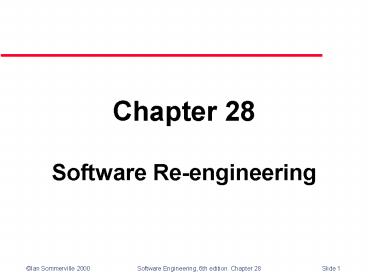Software Re-engineering PowerPoint PPT Presentation
1 / 20
Title: Software Re-engineering
1
Chapter 28
- Software Re-engineering
2
Software re-engineering
- Reorganising and modifying existing software
systems to make them more maintainable
3
Objectives
- To explain why software re-engineering is a
cost-effective option for system evolution - To describe the activities involved in the
software re-engineering process - To distinguish between software and data
re-engineering and to explain the problems of
data re-engineering
4
Topics covered
- Source code translation
- Reverse engineering
- Program structure improvement
- Program modularisation
- Data re-engineering
5
System re-engineering
- Re-structuring or re-writing part or all of a
legacy system without changing its
functionality - Applicable where some but not all sub-systems of
a larger system require frequent maintenance - Re-engineering involves adding effort to make
them easier to maintain. The system may be
re-structured and re-documented
6
When to re-engineer
- When system changes are mostly confined to part
of the system then re-engineer that part - When hardware or software support becomes
obsolete - When tools to support re-structuring are
available
7
Re-engineering advantages
- Reduced risk
- There is a high risk in new software development.
There may be development problems, staffing
problems and specification problems - Reduced cost
- The cost of re-engineering is often significantly
less than the costs of developing new software
8
Business process re-engineering
- Concerned with re-designing business processes to
make them more responsive and more efficient - Often reliant on the introduction of new computer
systems to support the revised processes - May force software re-engineering as the legacy
systems are designed to support existing processes
9
Forward engineering and re-engineering
10
The re-engineering process
11
Re-engineering cost factors
- The quality of the software to be re-engineered
- The tool support available for re-engineering
- The extent of the data conversion which is
required - The availability of expert staff for
re-engineering
12
Re-engineering approaches
13
Source code translation
- Involves converting the code from one language
(or language version) to another e.g. FORTRAN to
C - May be necessary because of
- Hardware platform update
- Staff skill shortages
- Organisational policy changes
- Only realistic if an automatic translator is
available
14
The program translation process
15
Reverse engineering
- Analysing software with a view to understanding
its design and specification - May be part of a re-engineering process but may
also be used to re-specify a system for
re-implementation - Builds a program data base and generates
information from this - Program understanding tools (browsers,
cross-reference generators, etc.) may be used in
this process
16
The reverse engineering process
17
Reverse engineering
- Reverse engineering often precedes re-engineering
but is sometimes worthwhile in its own right - The design and specification of a system may be
reverse engineered so that they can be an input
to the requirements specification process for the
systems replacement - The design and specification may be reverse
engineered to support program maintenance
18
Program structure improvement
- Maintenance tends to corrupt the structure of a
program. It becomes harder and harder to
understand - The program may be automatically restructured to
remove unconditional branches - Conditions may be simplified to make them more
readable
19
Spaghetti logic
20
Structured control logic

